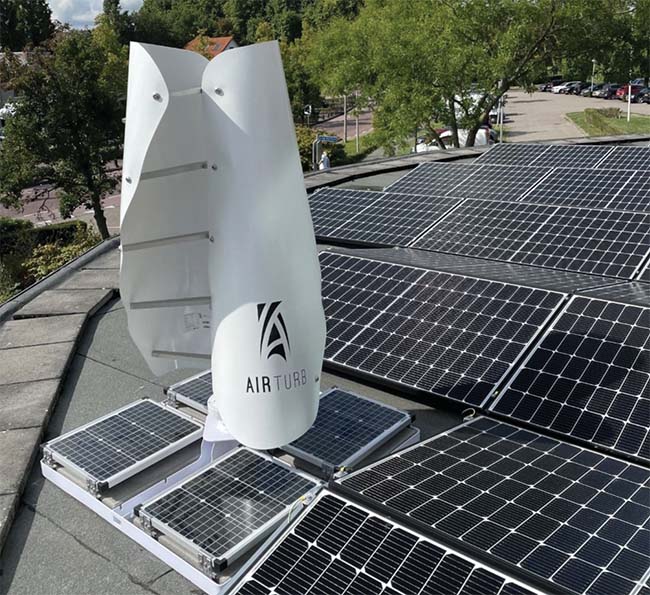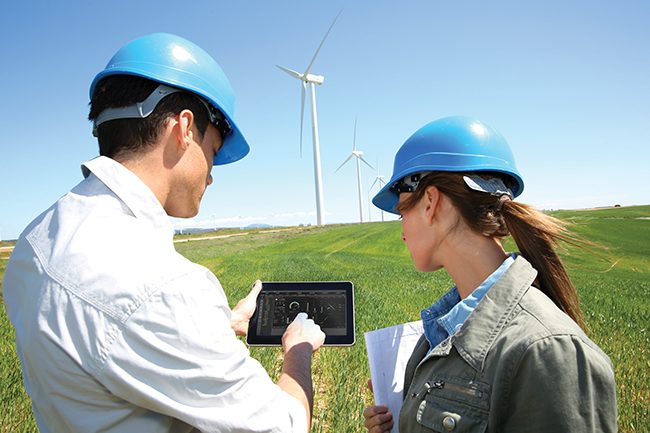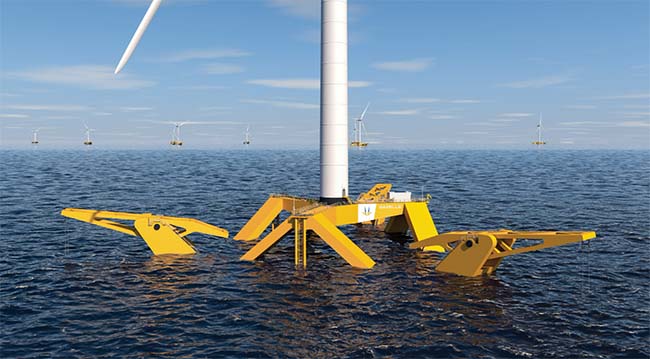New Tech Highlights Innovation, Spurs Growth in Wind Energy
Credit to Author: Darrell Proctor| Date: Thu, 01 Jun 2023 04:29:20 +0000

Onshore, offshore, and up in the air—the power of wind is evident in the changing energy landscape.
Advancements in wind power technology are many, with developers in both the onshore and offshore sectors working to design turbines capable of capturing more energy and producing more power.
The offshore market is experiencing competition among manufacturers to build ever-larger and more-powerful turbines, while also exploring platform designs that enable installation in deeper waters, in areas with stronger winds.
In the onshore market, manufacturers are moving beyond traditional horizontal axis turbines, designing vertical axis models that allow for capturing wind energy from any direction. These turbines, with a compact design, are being used in urban areas and installed on residential homes and commercial buildings, and have become a viable option for distributed energy generation.
A nascent technology is airborne wind energy, which uses small turbines mounted on aerial devices. This airborne tech is being used on drones, blimps, and kites, with dozens of startup companies active in the space.
There also is innovation for the digital technologies helping monitor and control this equipment.
“Wind energy production is growing rapidly, but with growth comes increased complexity. That complexity is created by the numerous technologies needed to operate and maintain wind generating assets,” said Thomas Andersen, vice president of Renewable Energy Technologies for Emerson. “A wind farm may use many differing systems for operating, monitoring, controlling, and maintaining each turbine. Such an infrastructure is already complex, but then a customer may add multiple wind farms, battery energy storage, and solar to their portfolio, increasing the complexity as the number of systems expands.”
 |
1. Field workers can monitor the operation of a wind farm using supervisory control and data acquisition technology. Courtesy: Emerson |
Companies, including Emerson, are offering scalable automation software and technologies that increase wind turbine and wind farm performance. This portfolio can include turbine and pitch control, wind farm optimization, supervisory control and data acquisition (SCADA, Figure 1), condition monitoring, and retrofit solutions.
Andersen told POWER: “Digital technologies offer a solution to complexity with a cohesive, integrated platform that helps simplify operations. Today, we’re seeing wind farm owners implement integrated fit-for-purpose automation technology that covers all wind operations, includes modern control logic with machine learning capabilities and is scalable from a single turbine to an entire portfolio. Armed with actionable information from a comprehensive set of contextualized data, owners are evaluating the right strategies to optimize operating life, production, and earning potential.”
More Power, More Control
WindESCo, based in Massachusetts, in late April told POWER its FIND, FIX, MEASURE (FFM) Saas (software as a service) analytics solution had been installed at the 600-MW Fantanele-Cogealac wind farm in Romania, operated by CEZ. The company said, “The technology will deliver turbine performance and reliability improvements, reverse efficiency losses from aging assets, and increase AEP [asset earning power] of one of Europe’s largest onshore wind plants.”
WindESCo said the FFM analyzes “high-resolution SCADA to deliver performance and reliability improvements, without the need for additional hardware. FFM pinpoints anomalies affecting wind turbine performance through 60+ continuous checks of the SCADA from every turbine. FFM then provides recommendations and instructions to fix each anomaly including the financial and AEP impact. Once fixes are completed, the system calculates and reports the performance improvements in both financial gain and additional MWh at the turbine, site, and fleet levels.”
Some of that technology is being put to the test as turbines become larger. GE Vernova, General Electric’s portfolio of energy businesses, earlier this year said it expects to have larger versions of its Haliade-X turbine available to the market soon, with models as large as 18 MW in development. GE Renewable Energy in December 2022 said it had received a full-type certificate of operations for its 14.7-MW Haliade-X, making it at that time the world’s most-powerful wind turbine.
Several Chinese companies, including CSSC Haizhuang, have announced development of 18-MW turbines, as that country continues to pursue not only larger turbines but also larger wind farms. China had installed 31 GW of offshore wind power capacity at the end of 2022, and the Global Wind Energy Council has said it expects China will add another 64 GW over the next five years.
“Sometimes ‘bigger’ is better—as in the case of wind turbines with large rotor diameters that can harvest more wind and produce more electricity, thus requiring fewer turbines to generate the needed amount of energy, which leads to lower cost,” said Andersen. “But the ‘race’ to larger turbines needs to be run with a strategy. Large or small, all turbines need to be monitored and maintained to drive peak performance and deliver the most return on investment. As owners and operators add assets of any size to their fleet, they still need built-for-purpose, comprehensive, integrated automation solutions to efficiently operate and maintain all turbines throughout their lifecycle.”
Building for purpose includes designing wind farms that can work in challenging conditions, both onshore, near shore, and far offshore. “In order to achieve worldwide decarbonization goals, it is necessary to develop more wind power, which requires overcoming land and near-shore constraints associated with onshore and fixed-bottom offshore wind,” said Jason Wormald, chief technology officer of Gazelle Wind Power, based in Dublin, Ireland. “Additionally, large turbines, ranging from 15 to 20 MW in size, will be needed to make the most of wind generation and ramp up capacities worldwide.”
Wormald told POWER, “The larger the turbines, the more cost-effective the installation, as the percentage reduction in both capital expenditures and overall turbine installation is greater.”
Innovation for Smaller Turbines
Smaller turbines, including some designed for areas of low wind, have entered the offshore market. SANY Renewable Energy has become among the world’s top 10 global wind turbine manufacturers, ranking ninth globally with 4 GW of installations over the past year. SANY is known for its 3-MW and 6-MW onshore turbines, some of them custom-made for specific geographies and/or climatic conditions. The company this year entered the offshore wind sector with the introduction of a 9-MW turbine designed for low-wind regions in China.
SANY said the new turbine has a 230-meter rotor diameter. The company said there is growing demand for lower-rated, longer-rotor turbines that can be installed in areas with low wind speeds. SANY said its high-speed drive train and doubly-fed induction generator is in contrast to other offshore turbines, which utilize medium-speed drive trains and permanent magnet generators.
Then there are smaller turbines set atop wooden towers. Modvion and RWE Renewables Sweden AB in late March announced a deal in which Modvion will supply wooden towers to RWE’s future onshore wind farms. RWE said it’s part of the company’s plan to reduce the carbon footprint of its wind power business.
“We see that modular towers in laminated wood have significant market potential and can contribute to lowering the cost of new renewable electricity production by replacing steel and concrete with environmentally friendly and climate-smart wood. RWE will be assessing Modvion’s wooden tower for potential use in future wind farms,” said Lars Borisson, head of Onshore Origination and Development Nordics at RWE.
“Our technology can help the wind industry dramatically reduce emissions, while facilitating taller towers to reach stronger winds,” said Maria-Lina Hedlund, CFO and acting CEO at Modvion. The company has said laminated wood is stronger than steel proportionate to its weight, which makes for lighter towers.
Modular Floating Platform
Designs for floating offshore wind installations continue to evolve. Gazelle Wind Power has developed a modular floating offshore wind platform (Figure 2), and has teamed with Portuguese renewable energy developer WAM Horizon on a pilot plant in Aguçadoura, Portugal, using the technology. The 25-MW WindFloat Atlantic Project is the first of its kind in Portugal, a country that wants to install at least 10 GW of offshore wind generation capacity this decade.
 |
2. Gazelle Wind Power’s modular floating offshore wind platform uses innovative technology to enable deployment in deep waters farther from shore. Courtesy: Gazelle Wind Power |
“WAM Horizon has exceptional offshore wind experience in the region, making them an ideal partner to support Gazelle’s project and help position our one-of-a-kind platform as the benchmark solution for floating offshore platforms,” said Gazelle CEO Jon Salazar. The platform uses a combination of semi-submersible designs and tension leg platforms to enable deployment in deeper offshore waters. Gazelle said the platform reduces costs because it is modular and scalable.
Salazar told POWER: “Onshore and even close-to-shore [less than 60 meters water depth] sites are scarce. Onshore and close-to-shore/fixed-bottom wind farms do not have the powerful winds that are felt in deeper waters. We must take advantage of wind generation farther out at sea. Fortunately, the place where the most innovative solutions are being introduced are in floating offshore wind. That is the next phase of development for the wind industry.”
Rooftop and Airborne
A company based in the Netherlands recently announced it has developed a hybrid wind-solar power system for residential applications (Figure 3). Airturb said its system includes a vertical-axis wind turbine with a modified helical Savonius shape. The turbine’s galvanized steel and rubber base can hold four 30-watt monocrystalline solar panels. Airturb said the system can be used on a rooftop—with a roof load of 131 kilograms per square meter—and for off-grid applications.
 |
3. Airturb’s vertical-axis turbine can be installed on a rooftop, and can work alongside solar panels. Courtesy: Airturb |
The wind power system includes a 300-watt axial-flux permanent-magnet synchronous alternator, or PMSA, that converts the mechanical energy into electrical energy, what Airturb characterizes as a three-phase alternating current. The hybrid system features a DualVolt Hybrid Inverter with an output of 500 watts. Airturb said its equipment can be installed with or without solar panels.
As for airborne wind energy, among its features is the ability to be deployed at sites where traditional wind turbines are not feasible, such as locations with low wind speeds or limited land availability. This makes the technology promising for distributed energy production, such as in remote or off-grid locations.
“The energy transition requires both powerful and efficient wind power generation to achieve decarbonization and sustainability goals,” said Andersen. “Harnessing power and efficiency in parallel is not difficult. It simply requires technology to expose more granular operation.”
—Darrell Proctor is a senior associate editor for POWER (@POWERmagazine).
The post New Tech Highlights Innovation, Spurs Growth in Wind Energy appeared first on POWER Magazine.